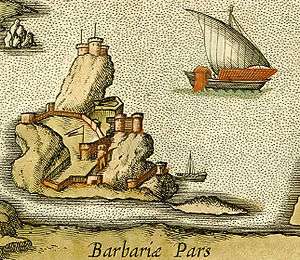Peñón of Algiers

Peñón of Algiers ("El Peñón de Argel") refers to a small islet off the coast of Algiers, fortified by the Kingdom of Spain during the 16th century. The islet was connected to the African continent to form a seawall and the harbour of Algiers.
History

Established in 1510 when the Spaniards settled on a small island in front of Algiers (modern Algeria), the Peñón of Algiers enforced Sālim al-Tūmī (Selim-bin-Teumi) to observe the terms of a treaty with Spain to accept a Spanish presence and to pay tribute.[1][2] Fortifications were built on the islet, and a garrison of 200 men was established.[2] Sālim al-Tūmī had to go to Spain to take an oath of obedience to Ferdinand of Aragon.[2]
The islet was captured in 1529 by Hayreddin Barbarossa in the Capture of Algiers (1529). Barbarossa dismantled the fortifications, ending the Spanish presence in the area.
References
Coordinates: 36°46′N 3°08′E / 36.767°N 3.133°E